Sir John Monash, Personal Files Book 12, 2 May - 31 May 1916, Part 12
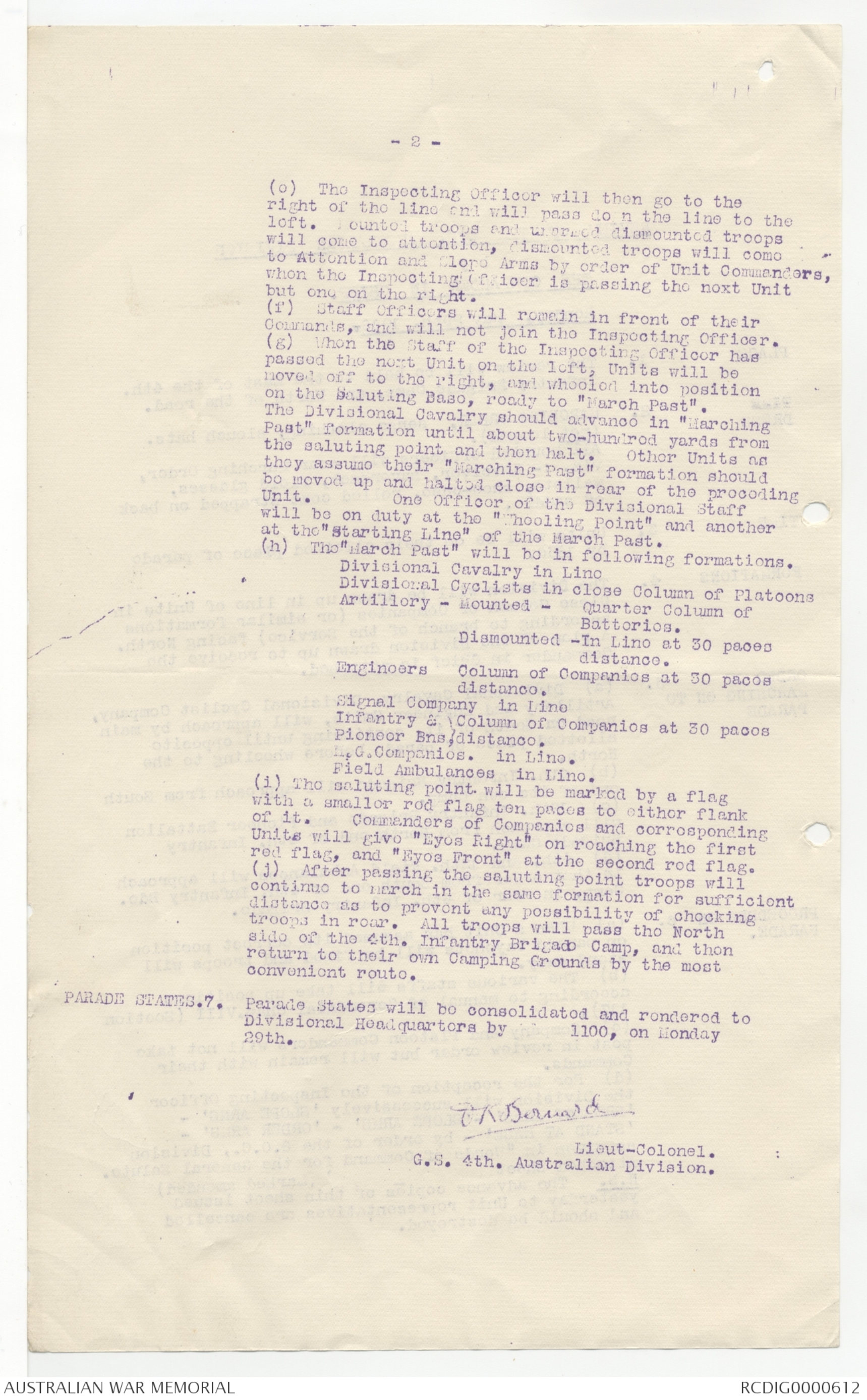
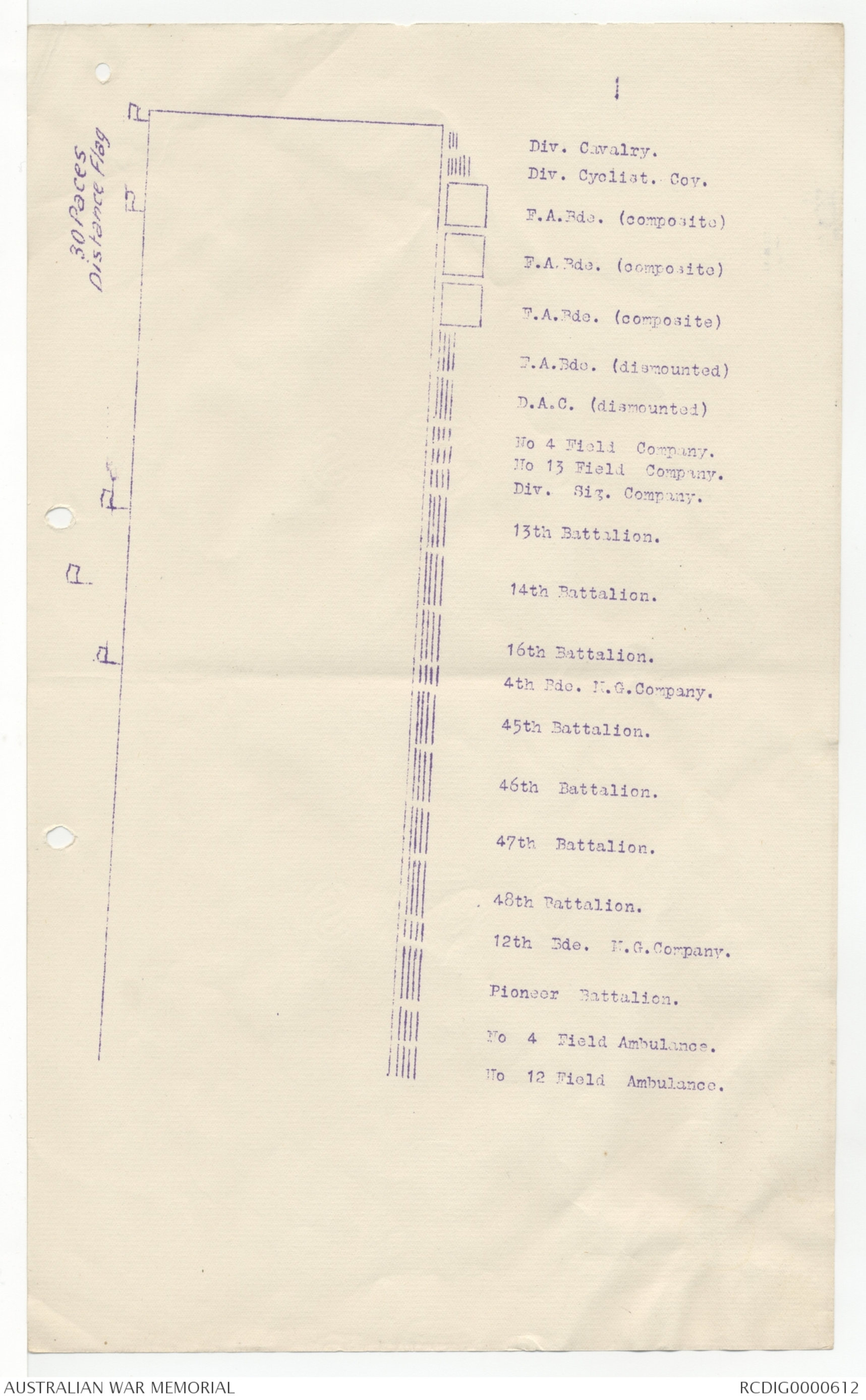
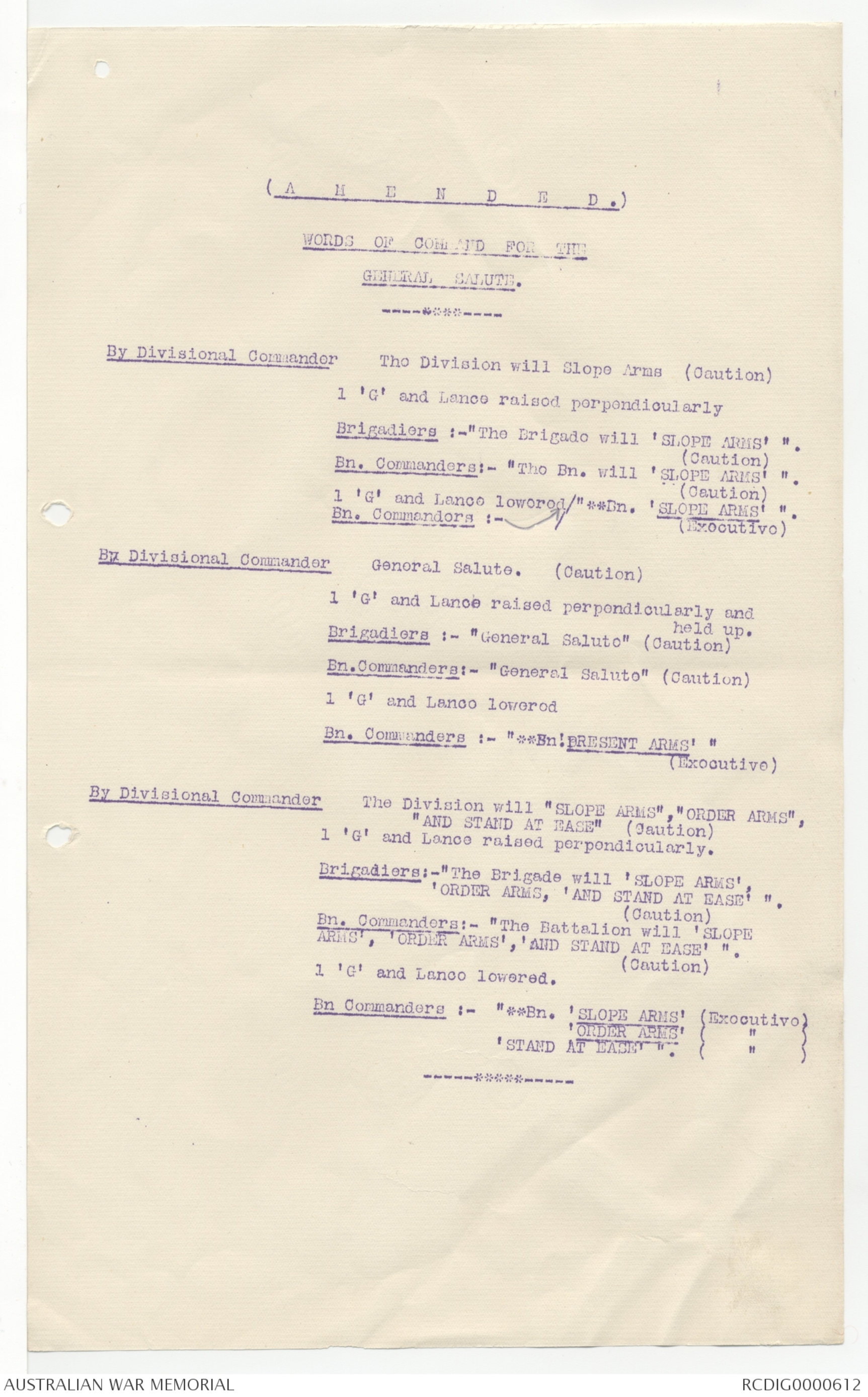
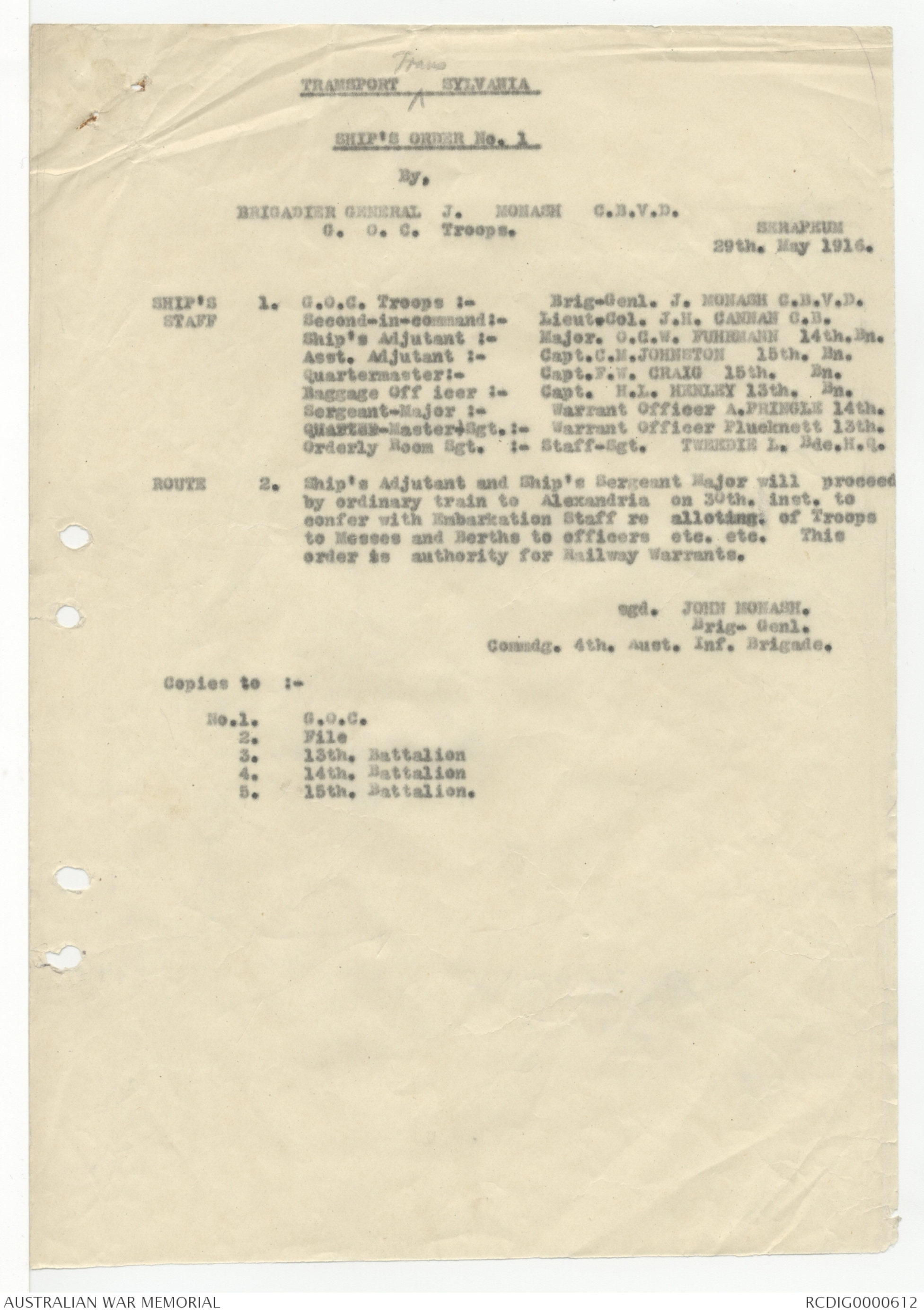
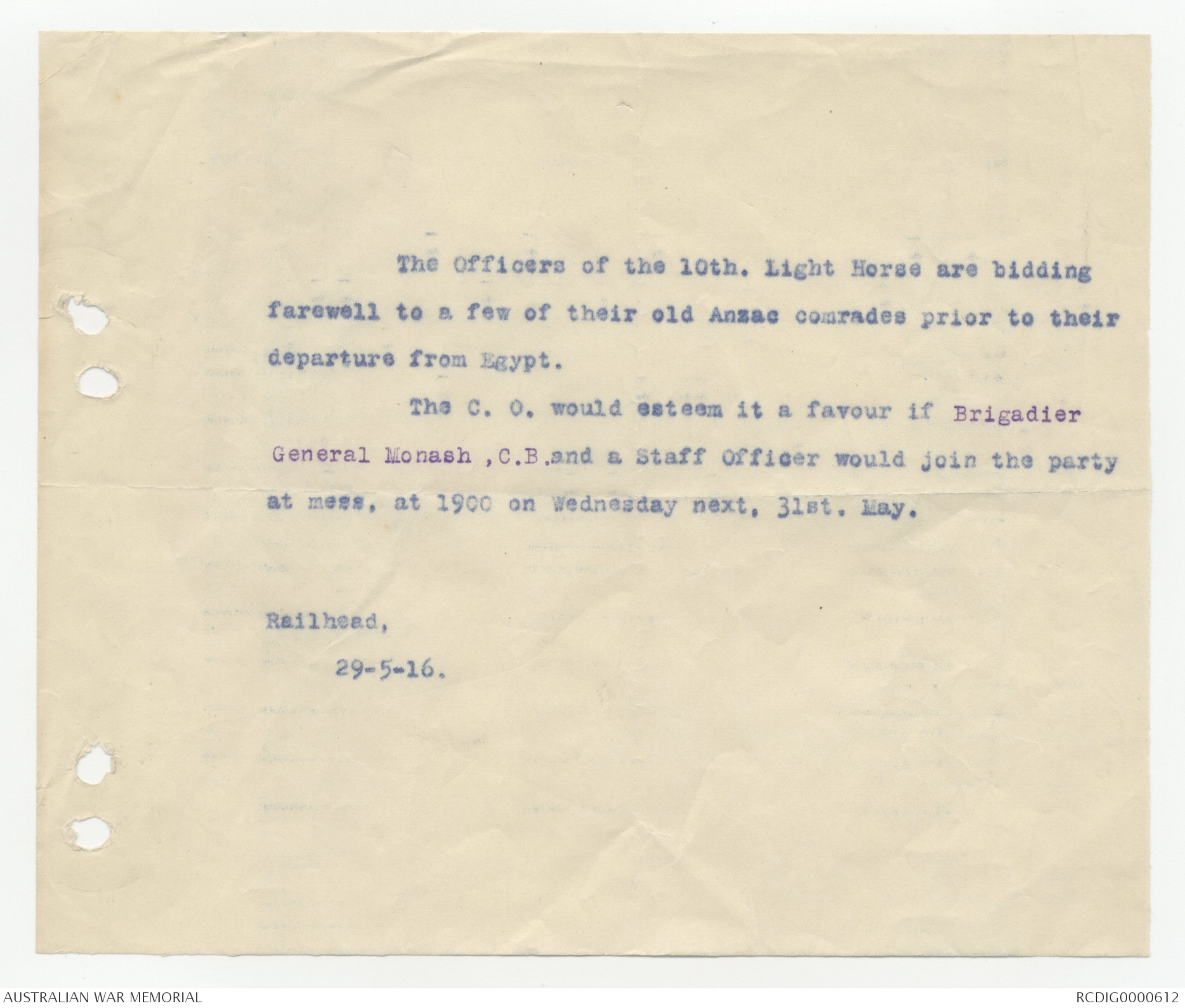
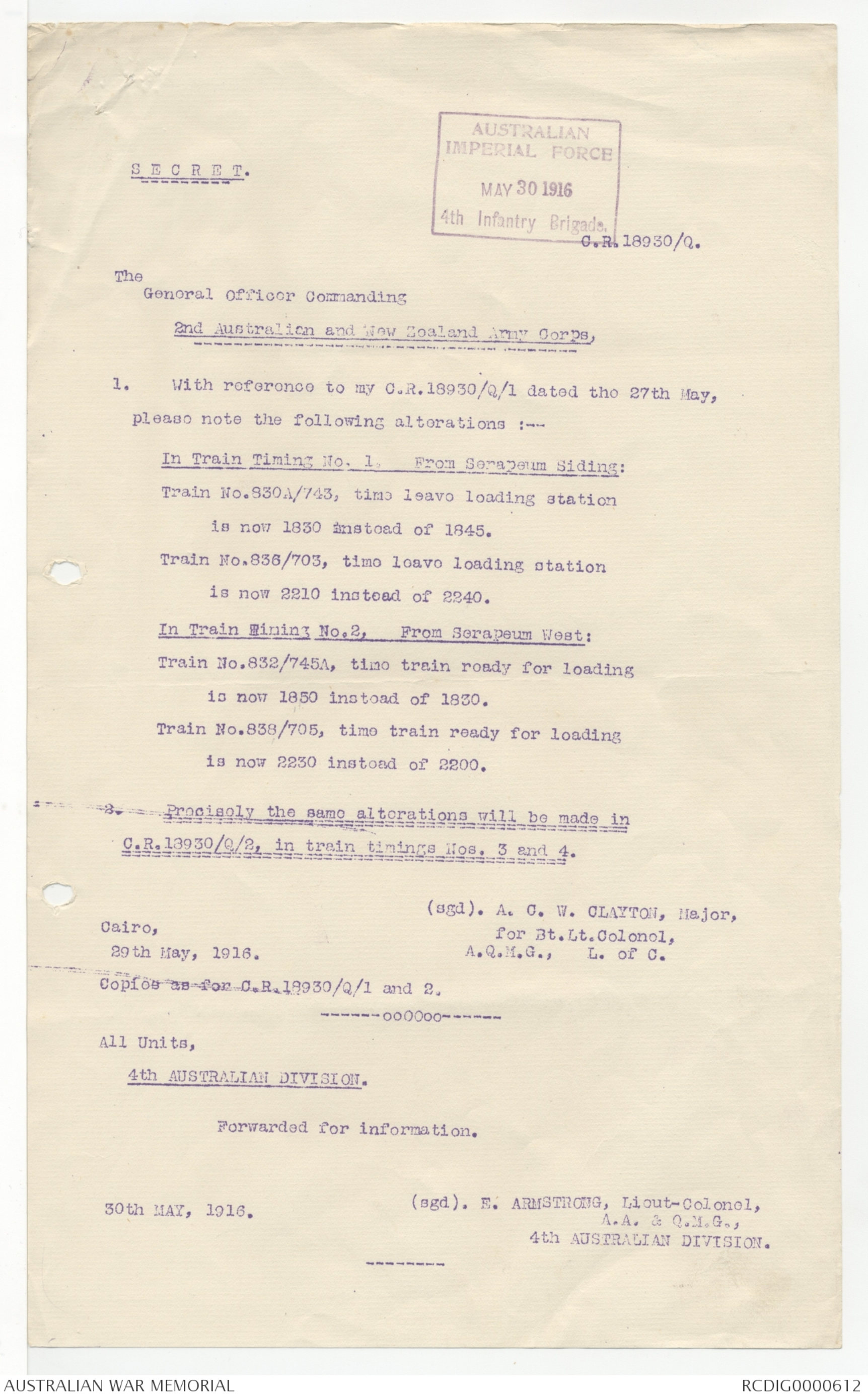
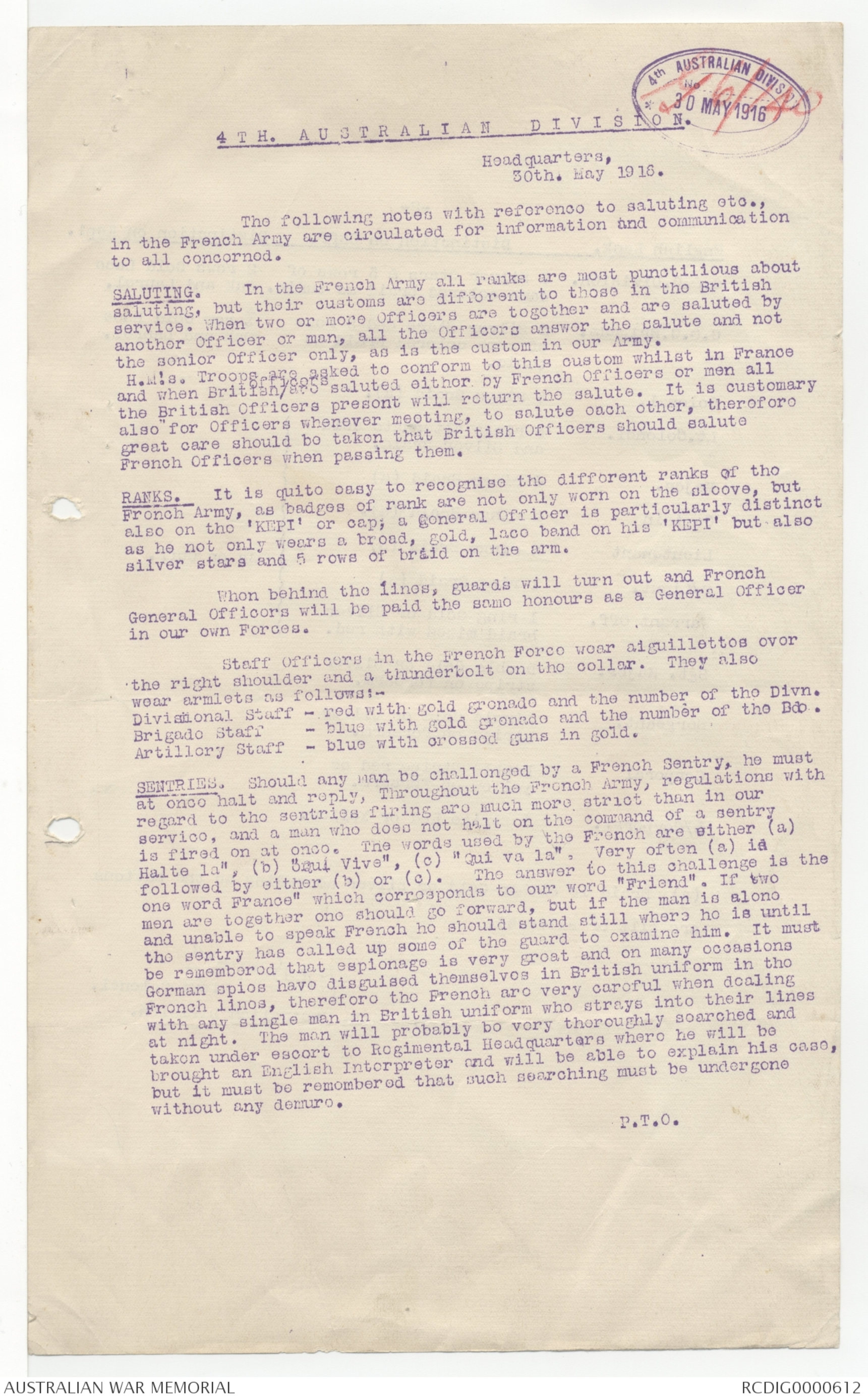
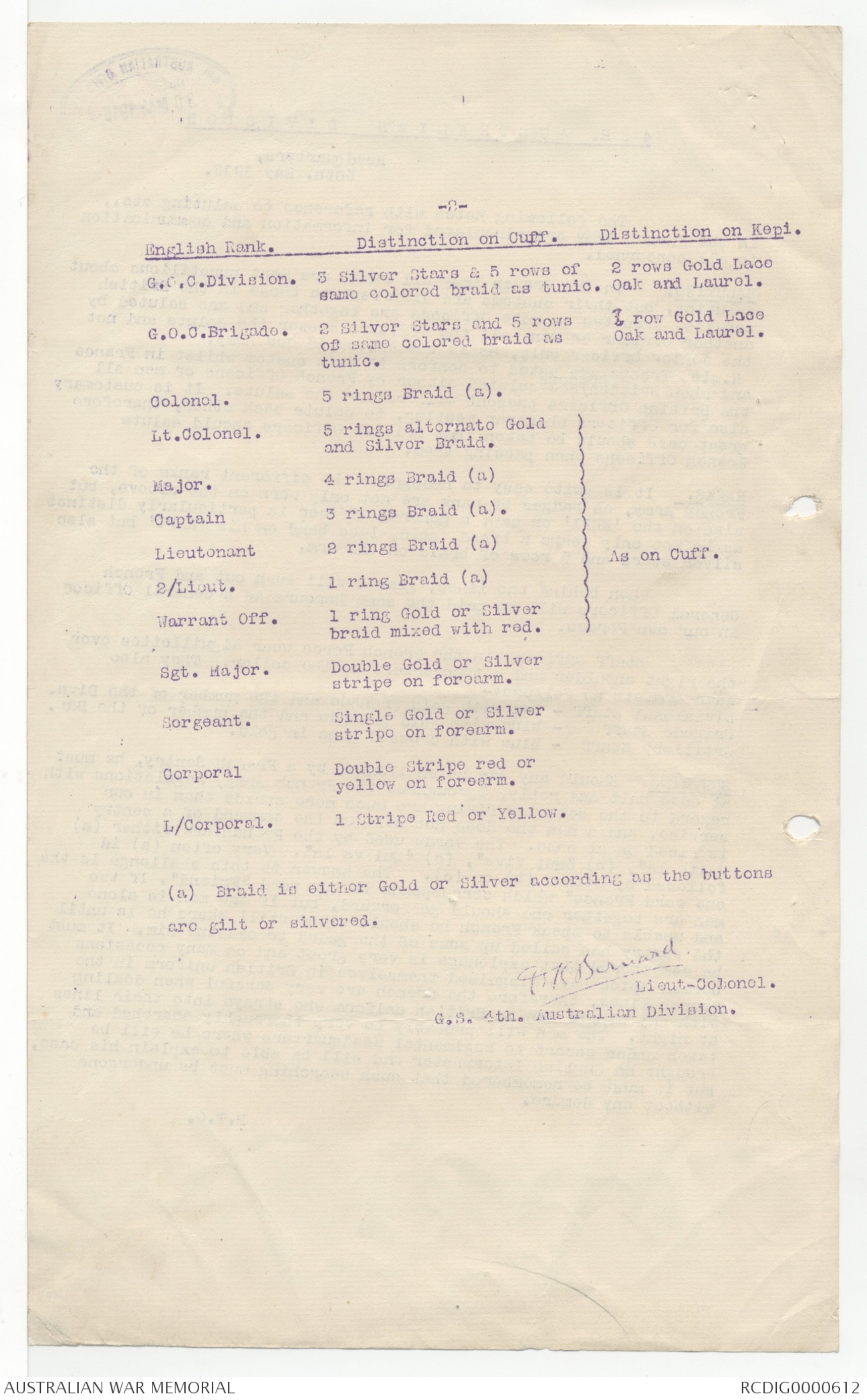
- 2 -
(e) The Inspecting Officer will then go to the
right of the line and will pass down the line to the
left. Mounted troops and unarmed dismounted troops
will come to attention, dismounted troops will come
to Attention and Slope Arms by order of Unit Commanders,
when the Inspecting Officer is passing the next Unit
but end on the right.
(f) Staff Officers will remain in front of their
Commands, and will not join the Inspecting Officer.
(g) When the Staff of the Inspecting Officer has
passed the next Unit on the left, Units will be
moved off to the right, and wheeled into position
on the Saluting Base, ready to "March Past".
The Divisional Cavalry should advance in "Marching
Past" formation until about two-hundred yards from
the saluting point and then halt. Other Units as
they assume their "Marching Past" formation should
be moved up and halted close in rear of the preceding
Unit. One Officer of the Divisional Staff
will be on duty at the "Wheeling Point" and another
at the "Starting Line" of the March Past.
(h) The "March Past" will be in following formations.
Divisional Cavalry in Line
Divisional Cyclists in close Column of Platoons
Artillery - Mounted - Quarter Column of
Batteries.
Dismounted - In Line at 30 paces
distance.
Engineers Column of Companies at 30 paces
distance.
Signal Company in Line
Infantry & Column of Companies at 30 paces
Pioneer Bns,distance.
H.G.Companies. in Line.
Field Ambulances in Line.
(i) The saluting point will be marked by a flag
with a smaller red flag ten paces to either flank
of it. Commanders of Companies and corresponding
Units will give "Eyes Right" on reaching the first
red flag, and "Eyes Front" at the second red flag.
(j) After passing the saluting point troops will
continue to march in the same formation for sufficient
distance as to prevent any possibility of checking
troops in rear. All troops will pass the North
side of the 4th. Infantry Brigade Camp, and then
return to their own Camping Grounds by the most
convenient route.
PARADE STATES.7. Parade States will be consolidated and rendered to
Divisional Headquarters by 1100, on Monday
29th.
D K Bernard
Lieut-Colonel.
G.S. 4th. Australian Division.
Diagram - see original document
(AMENDED.)
WORDS OF COMMAND FOR THE
GENERAL SALUTE.
By Divisional Commander The Division will Slope Arms (Caution)
1 'G' and Lance raised perpendicularly
Brigadiers :-"The Brigade will 'SLOPE ARMS'".
(Caution)
Bn. Commanders:- "The Bn. will 'SLOPE ARMS'".
(Caution)
1 'G' and Lance lowered /"**Bn. 'SLOPE ARMS'".
Bn. Commanders :- (Executive)
[*By Divisional Commander*] General Salute. (Caution)
1 'G' and Lance raised perpendicularly and
held up.
Brigadiers :- "General Salute" (Caution)
Bn. Commanders:- "General Salute" (Caution)
1 'G' and Lance lowered
Bn. Commanders :- "**Bn!PRESENT ARMS' "
(Executive)
By Divisional Commander The Division will "SLOPE ARMS", "ORDER ARMS",
"AND STAND AT EASE" (Caution)
1 'G' and Lance raised perpendicularly.
Brigadiers :-"The Brigade will 'SLOPE ARMS',
'ORDER ARMS, 'AND STAND AT EASE' ".
(Caution)
Bn. Commanders :- "The Battalion will 'SLOPE
ARMS', 'ORDER ARMS', 'AND STAND AT EASE' ".
(Caution)
1 'G' and Lance lowered.
Bn. Commanders :- "**Bn. 'SLOPE ARMS' (Executive)
'ORDER ARMS' ( " )
'STAND AT EASE' ". ( " )
TRANSPORT ^Trans SYLVANIA
SHIP'S ORDER No. 1
By,
BRIGADIER GENERAL J. MONASH C.B.V.D.
G.O.C. Troops. SERAPEUM
29th. May 1916.
SHIP'S STAFF 1. G.O.C. Troops :- Brig-Genl. J.MONASH C.B.V.D.
Second-in-command :-Lieut.Col. J.H. CANNAN C.B.
Ship's Adjutant :-Major. O/C/W/ FUHRMANN 14th.Bn.
Asst. Adjutant :-Capt.C.M.JOHNSTON 15th. Bn.
Quartermaster :-Capt.F.W. CRAIG 15th. Bn.
Baggage Off icer :-Capt. H.L.HENLEY 13th. Bn.
Sergeant-Major :-Warrant Officer A.PRINGLE 14th.
Quarter-Master-Sgt. :-Warrant Officer Plucknett 13th.
Orderly Room Sgt. :-Staff-Sgt TWERDIE L. Bde.H.Q.
ROUTE 2. Ship's Adjutant and Ship's Sergeant Major will proceed
by ordinary train to Alexandria on 30th. inst. to
confer with Embarkation Staff re allotting. of Troops
to Messes and Berths to officers etc. etc. This
order is authority for Railway Warrants.
sgd. JOHN MONASH.
Brig-Genl.
Commdg. 4th. Aust. Inf. Brigade.
Copies to:-
No.1. G.O.C.
2. File
3. 13th. Battalion
4. 14th. Battalion
5. 15th. Battalion.
The Officers of the 10th Light Horse are bidding
farewell to a few of their old Anzac comrades prior to their
departure from Egypt.
The C.O. would esteem it a favour if Brigadier
General Monash , C.B.and a Staff Officer would join the party
at mess, at 1900 on Wednesday next, 31st. May.
Railhead,
29-5-16.
SECRET.
AUSTRALIAN
IMPERIAL FORCE
MAY 30 1916
4th Infantry Brigade
C.R.18930/Q.
The
General Officer Commanding
2nd Australian and New Zealand Army Corps,
1. With reference to my C.R.18930/Q/1 dated the 27th May,
please note the following alterations :--
In Train Timing No. 1, From Serapeum Siding:
Train No.830A/743, time leave loading station
is now 1830 instead of 1845.
Train No.836/703, time leave loading station
is now 2210 instead of 2240.
In Train Timing No.2, From Serapeum West:
Train No.832/745A, time train ready for loading
is now 1850 instead of 1830.
Train No.838/705, time train ready for loading
is now 2230 instead of 2200.
2. Precisely the same alterations will be made in
C.R.18930/Q/2, in train timings Nos. 3 and 4.
(sgd). A. C. W. CLAYTON, Major,
for Bt.Lt.Colonel,
A.Q.M.G., L. of C.
Cairo,
29th May, 1916
Copies as for C.R.18930/Q/1 and 2.
All Units,
4th AUSTRALIAN DIVISION.
Forwarded for information.
30th MAY, 1916 (sgd). E. ARMSTRONG, Lieut-Colonel,
A.A. & Q.M.G.,
4th AUSTRALIAN DIVISION
4th Australian Division
No. G6/140
30 May 1916
4TH. AUSTRALIAN DIVISION.
Headquarters,
30th. May 1916
The following notes with reference to saluting etc.,
in the French Army are circulated for information and communication
to all concerned.
SALUTING. In the French Army all ranks are most punctilious about
saluting, but their customs are different to those in the British
service. When two or more Officers are together and are saluted by
another Officer or man, all the Officers answer the salute and not
the senior Officer only, as is the custom in our Army.
H.M.s. Troops are asked to conform to this custom whilst in France
and when British ∧Officers are saluted either by French Officers or men all
the British Officers present will return the salute. It is customary
also for Officers whenever meeting, to salute each other, therefore
great care should be taken that British Officers should salute
French Officers when passing them.
RANKS. It is quite easy to recognise the different ranks of the
French Army, as badges of rank are not only worn on the sleeve, but
also on the 'KEPI' or cap; a General Officer is particularly distinct
as he not only wears a broad, gold, lace band on his 'KEPI' but also
silver stars and 5 rows of braid on the arm.
When behind the lines, guards will turn out and French
General Officers will be paid the same honours as a General Officer
in our own Forces.
Staff Officers in the French Force wear aiguillettes over
the right shoulder and a thunderbolt on the collar. They also
wear armlets as follows:--
Divisional Staff - red with gold grenade and the number of the Divn.
Brigade Staff - blue with gold grenade and the number of the Bde.
Artillery Staff - blue with crossed guns in gold.
SENTRIES. Should any man be challenged by a French Sentry, he must
at once halt and reply, Throughout the French Army, regulations with
regard to the sentries firing are much more strict than in our
service, and a man who does not halt on the command of a sentry
is fired on at once. The words used by the French are either (a)
Halte la", (b) "Qui Vive", (c) "Qui va la". Very often (a) is
followed by either (b) or (c). The answer to this challenge is the
one word France" which corresponds to our word "Friend". If two
men are together one should go forward, but if the man is alone
and unable to speak French he should stand still where he is until
the sentry has called up some of the guard to examine him. It must
be remembered that espionage is very great and on many occasions
German spies have disguised themselves in British uniform in the
French lines, therefore the French are very careful when dealing
with any single man in British uniform who strays into their lines
at night. The man will probably be very thoroughly searched and
taken under escort to Regimental Headquarters where he will be
brought an English Interpreter and will be able to explain his case,
but it must be remembered that such searching must be undergone
without any demure.
P.T.O.
-2-
English Rank. Distinction on Cuff. Distinction on Kepi.
G.O.C.Division. 3 Silver stars & 5 rows of
same coloured braid as tunic.
2 rows Gold Lace
Oak and Laurel.
G.O.C.Brigade. 2 Silver Stars & 5 rows of
same coloured braid as tunic.
3 rows Gold Lace
Oak and Laurel.
Colonel. 5 rings Braid (a).
Lt. Colonel. 5 rings alternate Gold
and Silver braid.
Major. 4 rings Braid (a)
Captain 3 rings Braid (a).
As on Cuff.
Lieutenant 2 rings Braid (a)
2/Lieut. 1 ring Braid (a)
Warrant Off. 1 ring Gold or Silver
braid mixed with red.
Sgt. Major. Double Gold or Silver
stripe on forearm.
Sergeant. Single Gold or Silver
stripe on forearm.
Corporal Double Stripe red or
yellow on forearm.
L/Corporal. 1 Stripe Red or Yellow.
(a) Braid is either Gold or Silver according as the buttons
are gilt or silvered.
[[DK Bernard?]]
Lieut-Colonel.
G.S. 4th. Australian Division.
 Maralyn K
Maralyn KThis transcription item is now locked to you for editing. To release the lock either Save your changes or Cancel.
This lock will be automatically released after 60 minutes of inactivity.